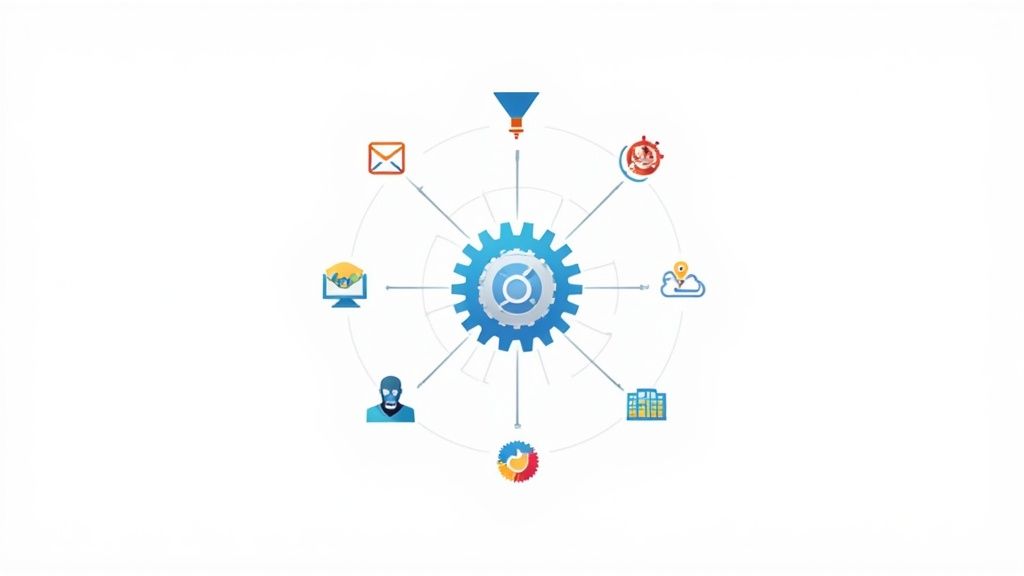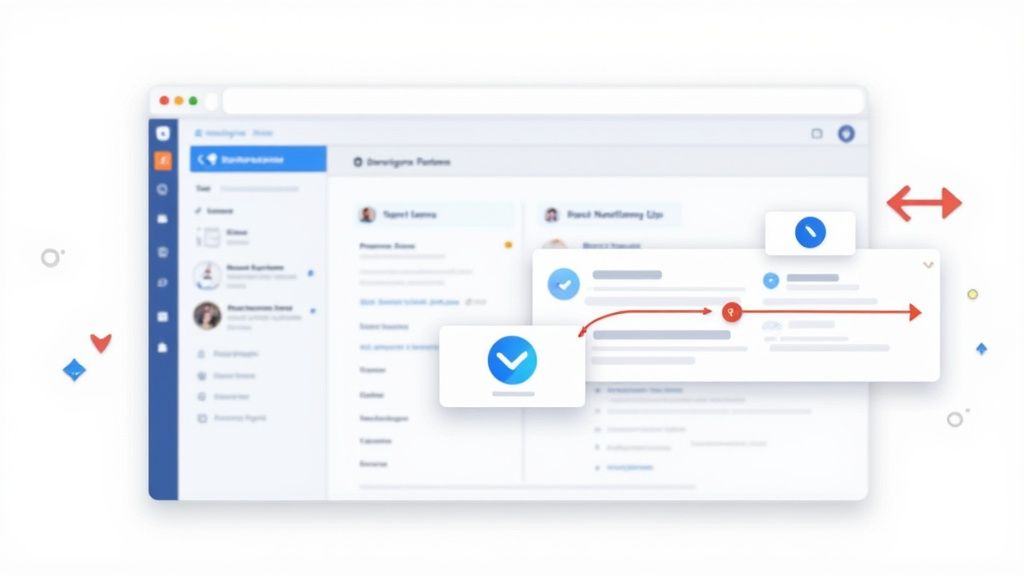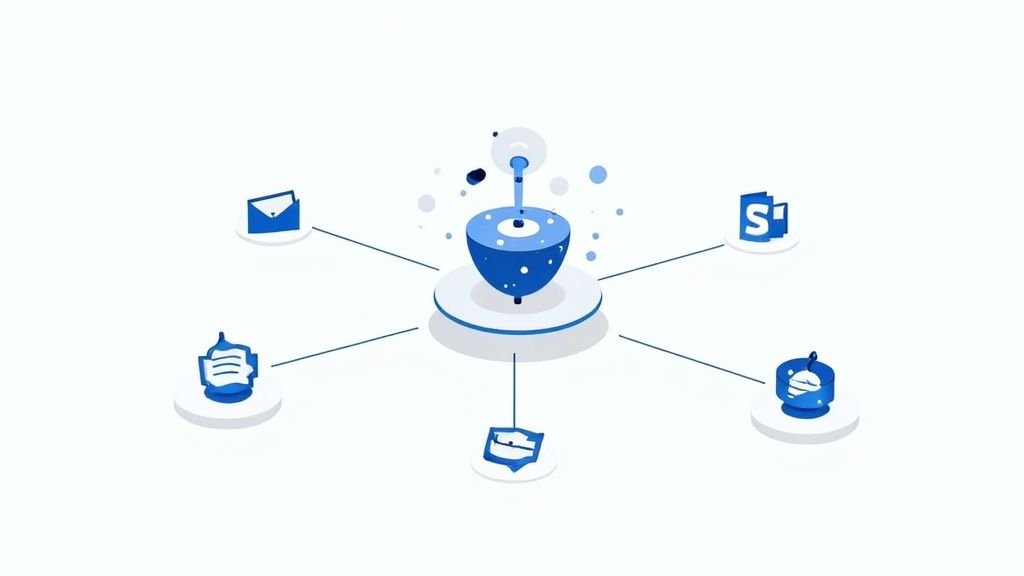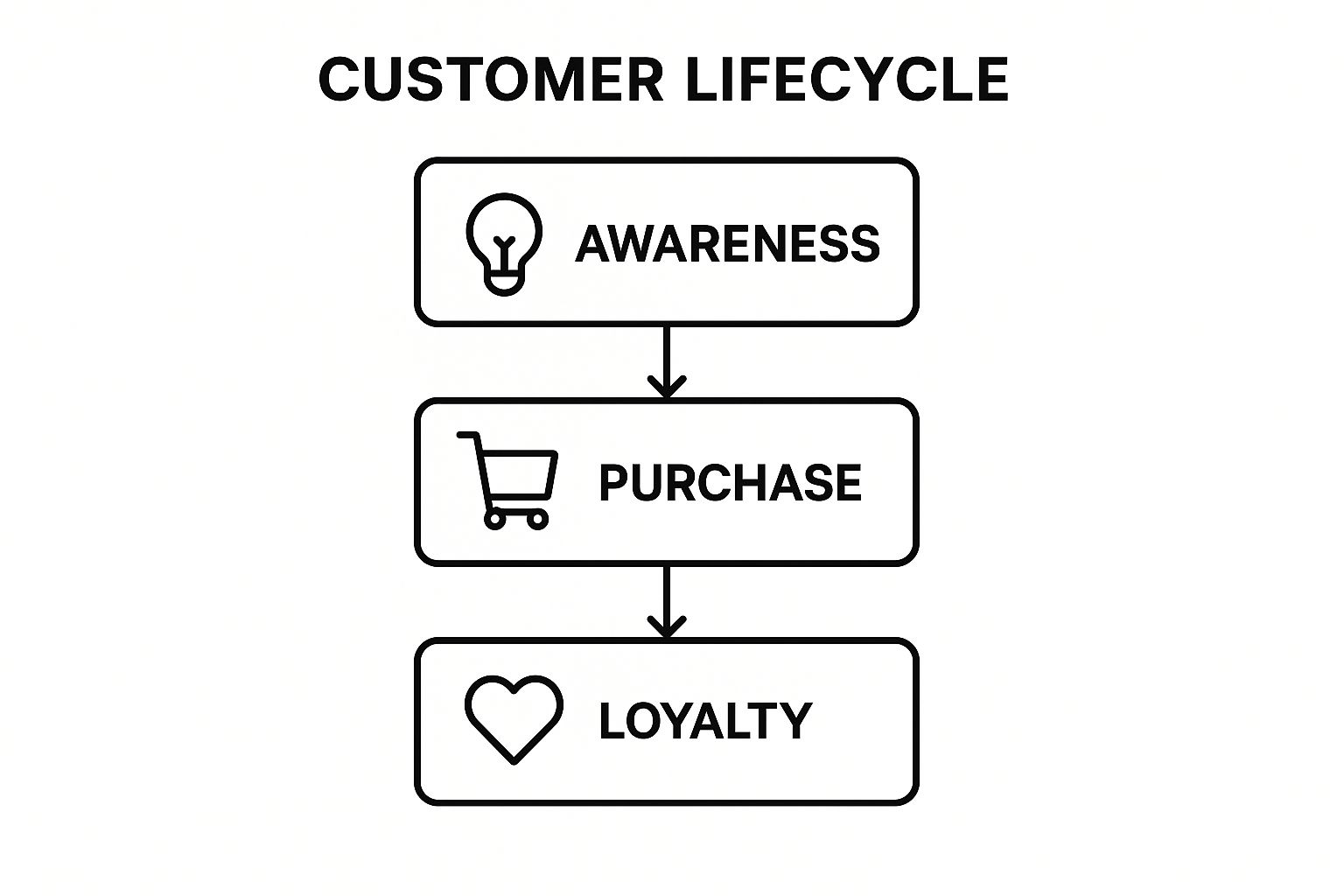8 Essential Marketing Automation Best Practices for 2025

In a competitive market where personalization and efficiency are paramount, mastering marketing automation is no longer optional—it's essential for survival and growth. Moving beyond simple email blasts, modern marketing automation allows you to create sophisticated, responsive, and highly personalized customer journeys at scale. The difference between a successful strategy and a noisy, ineffective one, however, lies entirely in the execution. Setting up automated workflows without a clear plan can lead to impersonal messages, alienated customers, and wasted resources.
This guide cuts through the clutter to reveal the core marketing automation best practices that deliver tangible results. We're not talking about generic tips; we're providing a blueprint for building a system that feels personal to your customers and is highly efficient for your team. From deep segmentation and intelligent lead scoring to behavior-triggered campaigns that react in real-time, these strategies are designed to be implemented immediately.
We'll explore eight proven best practices that empower you to connect with your audience meaningfully, streamline your workflows, and drive significant ROI. For a broader perspective on essential strategies, you can also delve into these 9 Marketing Automation Best Practices to Master in 2025 for additional insights. Whether you're just starting or looking to refine an existing setup, these actionable steps will help you transform your automation efforts from a simple tool into a powerful, revenue-generating growth engine. Let’s dive into the strategies that will make your marketing smarter, not just faster.
1. Customer Segmentation and Personalization
The foundation of any successful marketing automation strategy isn't the technology itself, but how well you understand the people you're communicating with. Customer segmentation is the practice of dividing your broad audience into smaller, more manageable groups based on shared characteristics. This allows for hyper-personalization, where you deliver tailored content, offers, and experiences that resonate deeply with each specific segment. Instead of a generic blast, every message feels like a one-on-one conversation.

This approach is fundamental because relevance drives results. A new lead requires a different message than a loyal, repeat customer. By segmenting, you can automate workflows that nurture new leads with educational content, re-engage lapsed customers with special offers, and reward VIPs with exclusive access. This level of granularity ensures your communications are always timely and relevant, significantly boosting open rates, click-through rates, and conversions.
How to Implement Segmentation and Personalization
Implementing this marketing automation best practice involves a strategic, data-driven approach. Start by identifying meaningful ways to group your audience.
- Demographic Segmentation: Group customers by age, gender, location, job title, or income level. This is often the easiest starting point.
- Behavioral Segmentation: This is where automation truly shines. Create segments based on user actions like website pages visited, emails opened, content downloaded, or past purchase history. For example, a "cart abandoner" segment can trigger an automated reminder email sequence.
- Psychographic Segmentation: Group users by their interests, values, and lifestyle. This requires deeper data analysis but can lead to highly effective campaigns.
- Firmographic Segmentation: For B2B companies, segmenting by company size, industry, or revenue allows you to tailor messaging to specific business needs.
Once segments are defined, use your automation platform's tools to deliver personalized content. Dynamic content blocks are invaluable here, allowing you to change specific parts of an email or landing page based on the recipient's segment. For instance, an e-commerce store can display different product recommendations within the same email template for customers who previously bought men's shoes versus those who bought women's dresses. A crucial part of this process is performing a thorough target audience analysis to ensure your segments are accurate and meaningful. This foundational analysis prevents you from making assumptions and helps you build campaigns that truly connect with your customers.
2. Lead Scoring and Nurturing Workflows
Once you've segmented your audience, the next step is to differentiate between casual browsers and serious potential buyers. Lead scoring is a systematic approach to ranking prospects based on their perceived value and likelihood to convert. This is combined with automated nurturing workflows that guide leads through the sales funnel with targeted, timely communication. This dual process ensures your sales team focuses its energy on the hottest leads while automation handles the crucial task of warming up everyone else.
This practice is essential for aligning marketing and sales efforts and maximizing efficiency. Instead of passing every single new contact to sales, marketing uses automation to qualify leads, sending over only those who have demonstrated a high level of interest and fit your ideal customer profile. This prevents sales from wasting time on unqualified prospects and ensures no potential customer falls through the cracks, dramatically shortening the sales cycle and increasing conversion rates.
How to Implement Lead Scoring and Nurturing
Implementing this marketing automation best practice requires close collaboration between your marketing and sales teams to define what constitutes a qualified lead.
- Define Scoring Criteria: Assign point values to different attributes and actions. Explicit criteria include demographic and firmographic data like job title, company size, or industry. Implicit criteria are behavioral, such as visiting the pricing page (+10 points), downloading an ebook (+15 points), or opening a specific email (+5 points).
- Establish a "Sales-Ready" Threshold: Work with sales to determine the score at which a lead is considered qualified and should be passed over. For example, any lead reaching 100 points is automatically assigned to a sales representative.
- Create Nurturing Tracks: Develop distinct, automated email sequences for leads at different stages or with different interests. A lead who downloaded a top-of-funnel guide receives a different track than one who requested a demo.
- Implement Negative Scoring: Not all actions are positive. Decrease a lead's score for disqualifying behaviors like visiting the careers page (-10 points) or being from a non-target industry (-50 points). Lead decay, which gradually reduces the score of inactive contacts, is also a crucial element.
Once a lead hits the sales-ready threshold, they are routed to the sales team. If they are not yet ready, they remain in a nurturing workflow designed to provide value and move them closer to a decision. Building an effective marketing workflow automation strategy for this process is key to ensuring a seamless handoff between marketing and sales, creating a cohesive and powerful customer journey.
3. Behavioral Trigger-Based Campaigns
Moving beyond static segments, one of the most powerful marketing automation best practices is to let customer actions dictate your communication. Behavioral trigger-based campaigns are automated sequences initiated by a specific user action or inaction. Instead of sending messages on a predetermined schedule, you react in real-time to what your audience is doing, delivering hyper-relevant content at the exact moment it's most impactful. This creates a dynamic, responsive conversation that feels personal and timely.

This approach is highly effective because it capitalizes on intent. A user adding an item to their cart, visiting a pricing page, or downloading a resource is signaling a specific interest. Triggered campaigns allow you to immediately follow up on that signal, guiding them further down the funnel before their attention wanes. This leads to significantly higher engagement and conversion rates compared to generic broadcast campaigns, as the message directly addresses a recent and relevant user behavior.
How to Implement Behavioral Trigger-Based Campaigns
Successfully implementing this strategy requires identifying high-intent customer actions and building automated workflows to respond to them. Platforms like Klaviyo and Drip excel at this.
- Abandoned Cart Recovery: This is a classic e-commerce example. If a user adds products to their cart but doesn't complete the purchase, trigger an automated email sequence that reminds them of the items, addresses potential barriers like shipping costs, and creates a sense of urgency.
- Welcome Series: When a new user subscribes to your newsletter or creates an account, trigger a welcome series. This workflow can introduce your brand, highlight key products or features, and provide value upfront to build a strong initial relationship.
- Post-Purchase Follow-Up: After a customer makes a purchase, trigger a sequence to thank them, provide shipping updates, request a review, or cross-sell related products. This builds loyalty and encourages repeat business.
- Website Re-engagement: If a lead visits a specific high-value page (like a demo request or pricing page) but doesn't convert, you can trigger an automated email with more information or a special offer related to that page.
To get started, map out key touchpoints in your customer journey and identify the most valuable actions. Use appropriate delays and frequency caps to ensure you're being helpful, not intrusive. For example, wait an hour before sending the first cart abandonment email. By monitoring campaign performance and testing different trigger conditions and timings, you can refine your automation to drive maximum results.
4. Multi-Channel Campaign Integration
Effective marketing automation extends far beyond a single channel like email. Multi-channel campaign integration is the practice of coordinating and synchronizing your marketing efforts across various platforms, including social media, SMS, push notifications, and advertising. This creates a seamless, unified brand experience, ensuring that your message is consistent and reinforced wherever a customer interacts with your brand, from their inbox to their social feed.

The goal is to meet your customers where they are, using the channels they prefer. A user who abandons their cart might first receive an email reminder. If they don't engage, your automation could trigger a retargeting ad on social media showing the exact product they left behind. This cohesive approach amplifies your message and moves customers through their journey more effectively than isolated, single-channel campaigns ever could. Integrating your efforts is one of the most powerful marketing automation best practices for building a persistent brand presence.
How to Implement Multi-Channel Integration
Building an integrated, multi-channel strategy requires a central automation hub and a clear understanding of the customer journey. The key is to make each channel work in concert with the others.
- Map the Customer Journey: Identify all potential touchpoints a customer might have with your brand. This will reveal the most logical channels to use at each stage, from awareness to post-purchase engagement.
- Utilize a Centralized Platform: Use a marketing automation tool like HubSpot or Salesforce Marketing Cloud that can manage workflows across email, social media, SMS, and ads. This allows for unified tracking and conditional logic, such as "if a user doesn't open this email, then show them this Facebook ad."
- Maintain a Consistent Brand Voice: While the content should be adapted for each channel's format, the core message, tone, and branding must remain consistent. This builds trust and brand recognition.
- Leverage Channel Preferences: Use data to understand which channels your different customer segments prefer. Send SMS messages for time-sensitive offers, use email for detailed content, and leverage social media for broader community engagement.
- Implement Cross-Channel Tracking: To measure success accurately, you need proper attribution. Use UTM parameters and integrated analytics to understand how different channels contribute to conversions and influence each other. For instance, you can track how an Instagram ad leads to an email sign-up and an eventual purchase.
5. A/B Testing and Continuous Optimization
Setting up your automation workflows is just the beginning. The most successful marketing strategies are not static; they are living systems that evolve through constant refinement. A/B testing, or split testing, is the practice of comparing two versions of a campaign element to see which one performs better. This data-driven approach removes guesswork from your strategy, allowing you to make incremental improvements that compound into significant gains over time.
This practice is one of the most crucial marketing automation best practices because it validates your assumptions with real user behavior. You might believe a certain subject line is compelling, but only a direct test against a variation can prove it. By continuously testing everything from email copy and send times to landing page layouts and calls-to-action, you can systematically optimize your automated campaigns for maximum engagement, conversions, and ROI.
How to Implement A/B Testing and Optimization
Integrating a culture of testing into your marketing automation involves a methodical and patient process. Start by identifying your key performance indicators (KPIs) and forming a hypothesis for what you want to improve.
- Test One Variable at a Time: To get clean, reliable data, only change one element between your control (Version A) and your variation (Version B). For example, test two different headlines on a landing page but keep the rest of the content identical.
- Ensure Statistical Significance: Don't end a test prematurely. Run it long enough to gather a sufficient sample size, ensuring the results aren't due to random chance. Most automation platforms will calculate statistical significance for you.
- Establish a Testing Calendar: Plan your tests in advance. A testing calendar helps you stay organized, prioritize high-impact experiments, and avoid running conflicting tests at the same time.
- Analyze and Document Results: Once a test concludes, analyze why one version won. Was the language more urgent? Did the color create better contrast? Document these findings to build a repository of insights that can inform future campaigns across the entire team.
For every automated email, workflow, or landing page you create, ask yourself what element could be tested. Platforms like Unbounce and Optimizely have popularized this process, but most modern marketing automation tools have robust A/B testing features built-in. This continuous loop of testing, learning, and iterating is the engine that drives sustainable growth. Applying these principles is central to any effective content optimization strategy and ensures your automated efforts improve with every send.
6. Customer Lifecycle Marketing
Effective marketing automation goes beyond one-off campaigns; it involves engaging customers throughout their entire journey with your brand. Customer lifecycle marketing is a strategic approach that maps and automates communications for each distinct stage, from initial awareness to long-term advocacy. Instead of treating all contacts the same, this practice tailors messaging and offers to where a customer is in their relationship with you, maximizing their lifetime value.

This methodology is crucial because a customer's needs and expectations evolve dramatically over time. A prospective lead requires educational content to build trust, while a loyal customer benefits from exclusive rewards and new product announcements. By automating stage-appropriate engagement, such as Dropbox's seamless freemium-to-paid conversion funnel or Amazon's trial-to-renewal sequences, you create a cohesive and supportive experience that prevents churn and fosters loyalty.
How to Implement Customer Lifecycle Marketing
Implementing this marketing automation best practice requires defining the key stages of your customer journey and building corresponding automated workflows. Start by mapping the path from prospect to advocate.
- Define Clear Lifecycle Stages: Establish firm criteria for each phase. For example, a "New Customer" might be someone who made their first purchase within the last 30 days, while an "At-Risk Customer" could be someone who hasn't engaged in 90 days.
- Craft Compelling Onboarding: Your first impression is critical. Create an automated onboarding sequence for new customers that welcomes them, highlights key product features, and provides immediate value, like Spotify’s new user engagement campaigns.
- Develop Win-Back Campaigns: Don't give up on churned customers. Implement automated workflows that trigger after a period of inactivity, offering a special incentive or highlighting new features to entice them back.
- Reward Loyalty and Encourage Advocacy: For your best customers, automate campaigns that offer exclusive perks, early access to new products, or referral bonuses. This turns satisfied customers into active brand advocates.
To execute this effectively, you must map your customer journey and identify the key triggers and touchpoints for each stage. Use your marketing automation platform to build workflows that move contacts from one stage to the next based on their behaviors and engagement data. This ensures your communication remains relevant and personalized at every step, transforming one-time buyers into lifelong fans.
7. Data Quality Management and GDPR Compliance
The effectiveness of your marketing automation is directly tied to the quality of the data that fuels it. Data quality management is the systematic process of ensuring your customer data is accurate, complete, and consistent. This practice is inseparable from modern privacy regulations like GDPR and CCPA, which mandate how personal data is collected, stored, and used. By prioritizing clean, compliant data, you not only improve campaign performance but also build trust and avoid significant legal penalties.
High-quality data ensures your personalization efforts are precise and your messages reach the right inboxes. Inaccurate or outdated information leads to wasted resources, poor deliverability, and a damaged sender reputation. Furthermore, adhering to data protection laws is no longer optional; it's a fundamental aspect of ethical marketing that respects customer privacy. Integrating data hygiene and compliance into your marketing automation best practices is crucial for long-term success and sustainability.
How to Implement Data Quality Management and Compliance
Effectively managing data quality and ensuring compliance requires a proactive, multi-faceted approach. Start by establishing clear internal processes and leveraging your platform's capabilities.
- Implement Double Opt-In: Require new subscribers to confirm their email address after signing up. This verifies interest, reduces bounce rates, and creates a clear record of consent, which is a cornerstone of GDPR.
- Conduct Regular Data Audits: Periodically review your database to identify and remove duplicate entries, correct formatting errors, and purge inactive or unengaged contacts. HubSpot and Salesforce offer built-in tools for data cleaning and monitoring.
- Establish Clear Consent Mechanisms: Your forms and landing pages must clearly state what a user is signing up for and how their data will be used. Provide granular options for consent and make it easy for users to manage their preferences or unsubscribe at any time.
- Standardize Data Entry: Use data validation rules and standardized fields in your forms to prevent incorrect or inconsistent data from entering your system in the first place.
- Create Robust Security Policies: For managing data quality and ensuring GDPR compliance, establishing robust information security policies is paramount. Consider exploring resources like these information security policy templates to build a framework that protects customer data.
By making data governance a core part of your strategy, you ensure your automation engine runs on premium fuel. Tools like OneTrust and TrustArc specialize in privacy management, helping you integrate consent and compliance workflows directly into your marketing stack, ensuring every automated communication is both effective and legally sound.
8. Marketing and Sales Alignment (Smarketing)
Marketing automation is most powerful when it bridges the gap between marketing and sales, creating a single, unified revenue team. This strategic alignment, often called "Smarketing," uses shared goals, data, and technology to build a seamless customer journey from the first touchpoint to the final sale. It transforms automation from a marketing-only tool into the connective tissue that ensures no lead is wasted and every opportunity is maximized.
This practice is essential because misalignment creates friction and inefficiency. When marketing generates leads that sales deems unqualified, or sales fails to follow up on high-quality leads, the entire funnel breaks down. By aligning these two teams, automation can facilitate a smooth handoff, provide sales with crucial context about a lead’s behavior, and give marketing valuable feedback on which campaigns are driving actual revenue, making it a critical marketing automation best practice.
How to Implement Smarketing
Achieving true alignment requires a formal framework and a commitment to collaboration, powered by your automation platform.
- Establish a Service Level Agreement (SLA): Create a formal document that defines each team's responsibilities. Marketing commits to delivering a specific number and quality of leads, while sales commits to a specific speed and volume of follow-up for those leads.
- Create Shared Definitions: Both teams must agree on the exact criteria for a Marketing Qualified Lead (MQL) and a Sales Qualified Lead (SQL). This is often based on lead scoring, ensuring sales only receives leads that have demonstrated sufficient interest and fit.
- Implement Closed-Loop Reporting: Use your automation platform to connect marketing activities directly to sales outcomes. When a deal closes in the CRM, that information should flow back to the marketing platform, showing exactly which campaigns, content, and channels influenced the win. This allows for data-driven optimization.
- Utilize Shared Resources: Build a centralized library of sales enablement content, such as case studies, one-pagers, and email templates, within your automation system. This ensures sales has easy access to marketing-approved materials that maintain brand consistency.
- Hold Regular Smarketing Meetings: Schedule weekly or bi-weekly check-ins to review the SLA, discuss lead quality, and strategize upcoming campaigns. This open line of communication is vital for resolving issues and identifying new opportunities for collaboration.
A key part of successful smarketing is leveraging technology to automate these processes. For instance, you can create automated workflows that change a lead's owner from marketing to a specific sales rep once their lead score hits the MQL threshold, simultaneously sending the rep an alert with the lead's complete activity history. Platforms like HubSpot and Salesforce are built around this philosophy, offering integrated tools that make this alignment a core function of their system.
Marketing Automation Best Practices Comparison
| Practice | 🔄 Implementation Complexity | 💡 Resource Requirements | 📊 Expected Outcomes | 💡 Ideal Use Cases | ⭐ Key Advantages |
|---|---|---|---|---|---|
| Customer Segmentation and Personalization | Medium to High: Data collection, management, compliance | High: Requires robust data systems and analytics | High engagement (up to 760% email revenue increase), better conversions | Targeted messaging, personalized user experiences | Significantly higher engagement, improved ROI, enhanced CLV |
| Lead Scoring and Nurturing Workflows | Medium to High: Scoring setup, ongoing tuning | Medium to High: CRM integrations and content creation | Improved sales efficiency (+14.5%), shorter sales cycles | Prioritizing leads, automated sales funnel management | Better lead conversion, sales & marketing alignment, clear ROI |
| Behavioral Trigger-Based Campaigns | Medium to High: Setup complex triggers and automation | Medium: Requires real-time tracking infrastructure | Higher engagement (up to 50% better than batch campaigns) | Timely, context-driven marketing | Better customer experience, increased conversions, automation efficiency |
| Multi-Channel Campaign Integration | High: Technical integration across platforms | High: Multi-channel content and budget needs | Increased brand recall, ROI (+287% on average) | Consistent brand messaging across channels | Unified brand experience, optimized channel usage, better attribution |
| A/B Testing and Continuous Optimization | Medium: Requires testing framework and statistical tools | Medium: Data analysis and test creation | Continuous campaign improvement, higher ROI | Data-driven marketing refinement | Data-backed decisions, reduced risk, deeper customer insights |
| Customer Lifecycle Marketing | High: Complex to implement, data-heavy | High: Multi-touch campaigns and analytics | Up to 30% higher CLV, better retention | Managing customer journey stages | Predictable revenue, enhanced satisfaction, efficient resource use |
| Data Quality Management and GDPR Compliance | Medium to High: Compliance workflows and validation | Medium to High: Ongoing audits and legal inputs | Increased deliverability and legal safety | Data integrity, privacy law adherence | Reduced legal risks, trust building, improved data accuracy |
| Marketing and Sales Alignment (Smarketing) | Medium: Process alignment and cultural change | Medium: Integrated systems & regular collaboration | Revenue increase (+36%), improved conversion | Sales and marketing coordination | Revenue growth, better lead quality, consistent customer experience |
From Automation to Acceleration: Your Next Steps
You've just navigated a comprehensive roadmap of marketing automation best practices, moving from foundational concepts like granular segmentation to advanced strategies like full-funnel lifecycle marketing. We've covered the critical pillars that transform automation from a simple time-saving tool into a powerful engine for predictable growth and enhanced customer relationships. The journey from manual effort to intelligent, scalable marketing doesn’t happen overnight, but by implementing these principles, you are building a resilient, data-driven framework for success.
The core message woven through each practice is this: automation empowers, it does not replace. It’s about leveraging technology to deliver the right message, to the right person, at the right moment, and on the right channel. It’s about freeing your talented team from repetitive tasks so they can focus on what truly matters: strategy, creativity, and the human connections that build brand loyalty.
Recapping Your Path to Mastery
Let's distill the journey we've taken into its most critical, actionable takeaways. Mastering these areas is the key to unlocking the full potential of your marketing efforts:
- Personalization is Non-Negotiable: Moving beyond
[First Name]is essential. True personalization, powered by deep customer segmentation and behavioral triggers, creates experiences that feel individual and relevant, dramatically boosting engagement and conversion. - Quality In, Quality Out: Your automation is only as effective as the data it runs on. Prioritizing data quality management and compliance isn't just a best practice; it's a foundational requirement for building trust and ensuring your campaigns hit their mark.
- Connect Every Dot: A customer's journey is not linear or confined to a single channel. The most successful strategies embrace multi-channel integration, creating a seamless, consistent brand experience whether a lead interacts with an email, a social ad, or your sales team.
- Optimization is a Continuous Loop: The 'set it and forget it' approach is a myth. The most effective marketers are relentless testers. By embedding A/B testing and continuous optimization into your culture, you turn every campaign into a learning opportunity, ensuring your strategy evolves and improves over time.
- Bridge the Marketing-Sales Divide: True acceleration happens when marketing and sales are perfectly aligned. Implementing transparent lead scoring and creating a unified "Smarketing" strategy ensures that marketing-qualified leads are seamlessly transitioned and nurtured into revenue.
Your Action Plan for Implementation
Feeling overwhelmed is natural, but progress is about taking the first step. The key is to avoid trying to boil the ocean. Instead, adopt a phased approach to implementing these marketing automation best practices.
- Start with an Audit: Where are you now? Evaluate your current data hygiene, segmentation capabilities, and lead nurturing processes. Identify the single biggest bottleneck or opportunity for improvement.
- Focus on One Core Workflow: Choose one high-impact area to tackle first. Is your lead nurturing sequence underperforming? Start there. Are your welcome emails generic? Begin by building a personalized, behavior-triggered onboarding series.
- Measure and Iterate: Define what success looks like for that single workflow. Is it a higher open rate, more demo requests, or a shorter sales cycle? Track the relevant metrics, learn from the results, and apply those insights to your next project.
By mastering one area, you build the momentum and expertise to tackle the next. Each optimized workflow, from lead scoring to customer lifecycle marketing, becomes a compounding asset. You're not just automating tasks; you are building a sophisticated system that nurtures leads, delights customers, and drives sustainable growth. This strategic application of marketing automation best practices is what separates stagnant programs from those that truly accelerate a business forward.
Ready to put these best practices into action with a platform designed for clarity and power? Lumeo provides the intuitive tools you need to build sophisticated, multi-channel workflows, segment your audience with precision, and align your marketing and sales teams effortlessly. Stop wrestling with clunky software and start accelerating your growth by visiting Lumeo to see how our platform makes automation simple and effective.